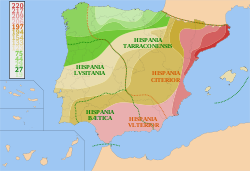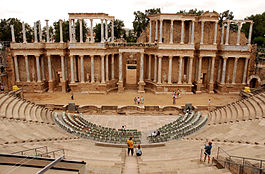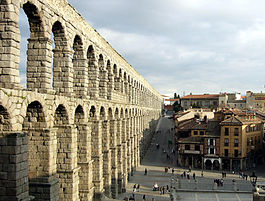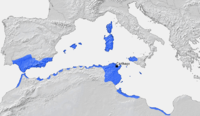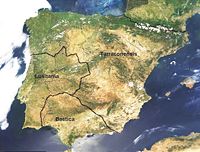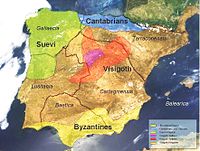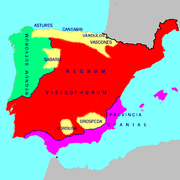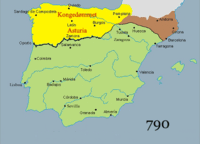- Hispania
-
Hispania ← 
218 BCE–400  →
→Roman provinces of Hispania Capital Baetica - Corduba
Ulterior - Emerita Augusta
Citerior - TarracoLanguage(s) Latin, various Paleohispanic languages Religion Traditional indigenous and Roman religion, followed by Christianity Government Autocracy Emperor - CE 98 - CE 117 Trajan - CE 117 - CE 138 Hadrian - CE 379 to CE 395 Theodosius I Legislature Roman Senate Historical era Classical antiquity - Established 218 BCE - Disestablished 400 Population - est. 5,000,000 or more Hispania was the Roman name for the Iberian Peninsula. Under the Republic, Hispania was divided into two provinces: Hispania Citerior and Hispania Ulterior. During the Principate, Hispania Ulterior was divided into two new provinces, Baetica and Lusitania, while Hispania Citerior was renamed Tarraconensis. Subsequently, the western part of Tarraconensis was split off, first as Hispania Nova, later renamed Callaecia (or Gallaecia, whence modern Galicia). From Diocletian's Tetrarchy (CE 284) onwards, the south of remaining Tarraconensis was again split off as Carthaginensis, and probably then too the Balearic Islands and all the resulting provinces formed one civil diocese under the vicarius for the Hispaniae (that is, the Celtic provinces). The name, Hispania, was also used in the period of Visigothic rule. The modern name España (Spain) derives from Hispania.
Contents
Name
The origin of the word Hispania is much disputed and the evidence for the various speculations are based merely upon what are at best mere resemblances, likely to be accidental, and suspect supporting evidence. One theory holds it to be of Punic derivation, from the Phoenician language of colonizing Carthage.[1] Specifically, it may derive from a Punic cognate of Hebrew אי-שפניא (i-shfania) meaning "Island of the Hyrax" or "island of the hare" or "island of the rabbit" (Phoenician-Punic and Hebrew are both Canaanite languages and therefore closely related to each other). Another theory, proposed by the etymologist Eric Partridge in his work Origins, is that it is of Iberian derivation and that it is to be found in the pre-Roman name for Seville, Hispalis, which strongly hints at an ancient name for the country of *Hispa, an Iberian or Celtic root whose meaning is now lost. It may alternatively derive from Heliopolis (Greek for "city of the sun"). Occasionally it was called Hesperia, the western land, by Roman writers, or Hesperia ultima.
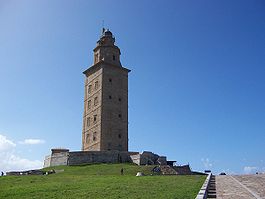 The Tower of Hercules in A Coruña, Galicia, Spain, is the world's oldest Roman lighthouse still used as a lighthouse.[2]
The Tower of Hercules in A Coruña, Galicia, Spain, is the world's oldest Roman lighthouse still used as a lighthouse.[2]
Another theory holds that the name derives from Ezpanna, the Basque word for "border" or "edge", thus meaning the farthest area or place.[3][4] Isidore of Sevilla considered Hispania derived from Hispalis.[5]
Although "Hispania" is the Latin root for the modern name "Spain", substituting Spanish for Hispanicus or Hispanic, or Spain for Hispania, though sometimes done by historians in the more general context of a common peninsular history, is anachronistic and can be misleading, since the borders of modern Spain do not coincide with those of the Roman province of Hispania or of the Visigothic Kingdom of the same name which succeeded it, and have always shifted, and so does not even include the territory of present day Portugal. The Latin term Hispania was often used during Antiquity and the High Middle Ages as a geographical name for the Iberian Peninsula, but its modern cognates, Spain and Spanish, have become increasingly associated with the Kingdom of Spain alone, after the union of the central peninsular Kingdom of Castile with the eastern peninsular Kingdom of Aragon in the 15th century under the Catholic Monarchs.
Pre-Roman history
The Iberian peninsula has long been inhabited, first by early hominids such as Homo erectus, Homo heidelbergensis and Homo antecessor. In the Paleolithic period, the Neanderthals entered Iberia and eventually took refuge from the advancing migrations of modern humans. In the 40th millennium BC, during the Upper Paleolithic and the last ice age, the first large settlement of Europe by modern humans occurred. These were nomadic hunter-gatherers originating on the steppes of Central Asia. When the last Ice Age reached its maximum extent, during the 30th millennium BC, these modern humans took refuge in Southern Europe, namely in Iberia, after retreating through Southern France. In the millennia that followed, the Neanderthals became extinct and local modern human cultures thrived, producing pre-historic art such as that found in L'Arbreda Cave and in the Côa Valley.
In the Mesolithic period, beginning in the 10th millennium BC, the Allerød Oscillation occurred. This was an interstadial deglaciation that lessened the harsh conditions of the Ice Age. The populations sheltered in Iberian Peninsula (descendants of the Cro-Magnon) migrated and recolonized all of Western Europe. In this period one finds the Azilian culture in Southern France and Northern Iberia (to the mouth of the Douro river), as well as the Muge Culture in the Tagus valley.
The Neolithic brought changes to the human landscape of Iberia (from the 5th millennium BC onwards), with the development of agriculture and the beginning of the European Megalith Culture. This spread to most of Europe and had one of its oldest and main centres in the territory of modern Portugal, as well as the Chalcolithic and Beaker cultures.
During the 1st millennium BC, in the Bronze Age, the first wave of migrations into Iberia of speakers of Indo-European languages occurred. These were later (7th and 5th centuries BC) followed by others that can be identified as Celts. Eventually urban cultures developed in southern Iberia, such as Tartessos, influenced by the Phoenician colonization of coastal Mediterranean Iberia, with strong competition from the Greek colonization. These two processes defined Iberia's cultural landscape – Mediterranean towards the southeast and a Continental in the northwest.
Languages
Linguistic map: This shows the Linguistic variation of the Iberian Peninsula at about 200 BCE (at the end of the Second Punic War).
Latin was the official language of Hispania during the Roman Empire's 600 year reign over the area ending around 400 AD, even though the native languages of the Pre-Roman peoples of the Iberian Peninsula persisted. Even after the fall of Rome and the invasion of the Germanic Visigoths and Suebi, Latin was spoken by the majority of the Hispano-Roman population, but, as in most areas of the Roman Empire that maintained Latin, it had by then evolved into Vulgar Latin, from where all of the modern languages of the Iberian Peninsula derive (the Iberian Romance languages) with the exception of Basque.
Carthaginian Hispania
After its defeat by the Romans in the First Punic War (264 BC–241 BC), Carthage compensated for its loss of Sicily by rebuilding a commercial empire in Hispania.
The major part of the Punic Wars, fought between the Punic Carthaginians and the Romans, was fought on the Iberian Peninsula. Carthage gave control of the Iberian Peninsula and much of its empire to Rome in 201 BC as part of the peace treaty after its defeat in the Second Punic War, and Rome completed its replacement of Carthage as the dominant power in the Mediterranean area. By then the Romans had adopted the Carthaginian name, romanized first as Ispania. The term later received an H, much like what happened with Hibernia, and was pluralized as Hispaniae, as had been done with the Three Gauls.
Roman Hispania
Roman armies invaded Hispania in 218 BC and used it as a training ground for officers and as a proving ground for tactics during campaigns against the Carthaginians, the Iberians, the Lusitanians, the Gallaecians and other Celts. It was not until 19 BC that the Roman emperor Augustus (r. 27 BC–AD 14) was able to complete the conquest (see Cantabrian Wars). Until then, much of Hispania remained autonomous.
Romanization proceeded quickly in some regions where we have references to the togati, and very slowly in others, after the time of Augustus, and Hispania was divided into three separately governed provinces (nine provinces by the 4th century). More importantly, Hispania was for 500 years part of a cosmopolitan world empire bound together by law, language, and the Roman road. But the impact of Hispania in the newcomers was also big. Caesar wrote on the Civil Wars that the soldiers from the Second Legion had become Hispanicized and regarded themselves as hispanicus.
Some of the peninsula's population were admitted into the Roman aristocratic class and they participated in governing Hispania and the Roman empire, although there was a native aristocracy class who ruled each local tribe. The latifundia (sing., latifundium), large estates controlled by the aristocracy, were superimposed on the existing Iberian landholding system.
The Romans improved existing cities, such as Lisbon (Olissipo) and Tarragona (Tarraco), established Zaragoza (Caesaraugusta), Mérida (Augusta Emerita), and Valencia (Valentia), and reduced other native cities to mere villages. The peninsula's economy expanded under Roman tutelage. Hispania served as a granary and a major source of metals for the Roman market, and its harbors exported gold, tin, silver, lead, wool, wheat, olive oil, wine, fish, and garum . Agricultural production increased with the introduction of irrigation projects, some of which remain in use today. The Romanized Iberian populations and the Iberian-born descendants of Roman soldiers and colonists had all achieved the status of full Roman citizenship by the end of the 1st century. The emperors Trajan (r. 98–117), Hadrian (r. 117–138), and Marcus Aurelius (r. 161–180) were born in Hispania. The Iberian denarii, also called argentum oscense by Roman soldiers, circulated until the 1st century BC, after which it was replaced by Roman coins.
Hispania was separated into two provinces (in 197 BC), each ruled by a praetor: Hispania Citerior ("Nearer Hispania") and Hispania Ulterior ("Farther Hispania"). The long wars of conquest lasted two centuries, and only by the time of Augustus did Rome managed to control Hispania Ulterior. Hispania was divided into three provinces in the 1st century BC.
In the 4th century, Latinius Pacatus Drepanius, a Gallic rhetorician, dedicated part of his work to the depiction of the geography, climate and inhabitants of the peninsula, writing:
- This Hispania produces tough soldiers, very skilled captains, prolific speakers, luminous bards. It is a mother of judges and princes; it has given Trajan, Hadrian, and Theodosius to the Empire.
With time, the name Hispania was used to describe the collective names of the Iberian Peninsula kingdoms of the Middle Ages, which came to designate all of the Iberian Peninsula plus the Balearic Islands.
The Hispaniae
During the first stages of Romanization, the peninsula was divided in two by the Romans for administrative purposes. The closest one to Rome was called Citerior and the more remote one Ulterior. The frontier between both was a sinuous line which ran from Cartago Nova (now Cartagena) to the Cantabrian Sea.
Hispania Ulterior comprised what are now Andalusia, Portugal, Extremadura, León, a great portion of the former Castilla la Vieja, Galicia, Asturias, and the Basque Country.
Hispania Citerior comprised the eastern part of former Castilla la Vieja, and what are now Aragon, Valencia, Catalonia, and a major part of former Castilla la Nueva.
In the year BC 27 the general and politician Marcus Vipsanius Agrippa divided Hispania into three parts, namely dividing Hispania Ulterior into Baetica (basically Andalusia) and Lusitania (including Gallaecia and Asturias) and attaching Cantabria and the Basque Country to Hispania Citerior.
The emperor Augustus in that same year returned to make a new division leaving the provinces as follows:
- Provincia Hispania Ulterior Baetica (Hispania Baetica), whose capital was Corduba, presently Córdoba. It included a little less territory than present-day Andalusia—since modern Almería and a great portion of what today is Granada and Jaén were left outside—plus the southern zone of present-day Badajoz. The river Anas or Annas (Guadiana, from Wadi-Anas) separated Hispania Baetica from Lusitania.
- Provincia Hispania Ulterior Lusitania, whose capital was Emerita Augusta (now Mérida) and without Gallaecia and Asturias.
- Provincia Hispania Citerior, whose capital was Tarraco (Tarragona). After gaining maximum importance this province was simply known as Tarraconensis and it comprised Gallaecia (modern Galicia and northern Portugal) and Asturias. In AD 69, the province of Mauretania Tingitana was incorporated into the Diocesis Hispaniarum.
By the 3rd century the emperor Caracalla made a new division which lasted only a short time. He split Hispania Citerior again into two parts, creating the new provinces Provincia Hispania Nova Citerior and Asturiae-Calleciae. In the year 238 the unified province Tarraconensis or Hispania Citerior was re-established.
In the 3rd century, under the Soldier Emperors, Hispania Nova (the northwestern corner of Spain) was split off from Tarraconensis, as a small province but the home of the only permanent legion is Hispania, Legio VII Gemina. Beginning with Diocletian's Tetrarchy reform in AD 293, the new dioecesis Hispaniae became one of the four dioceses—governed by a vicarius—of the praetorian prefecture of Gaul (also comprising the provinces of Gaul, Germania and Britannia), after the abolition of the imperial Tetrarchs under the Western Emperor (in Rome itself, later Ravenna). The diocese, with capital at Emerita Augusta (modern Mérida), comprised the five peninsular Iberian provinces (Baetica, Gallaecia and Lusitania, each under a governor styled consularis; and Carthaginiensis, Tarraconensis, each under a praeses), the Insulae Baleares and the North African province of Mauretania Tingitana.
Christianity was introduced into Hispania in the 1st century and it became popular in the cities in the 2nd century. Little headway was made in the countryside, however, until the late 4th century, by which time Christianity was the official religion of the Roman Empire. Some heretical sects emerged in Hispania, most notably Priscillianism, but overall the local bishops remained subordinate to the Pope. Bishops who had official civil as well as ecclesiastical status in the late empire continued to exercise their authority to maintain order when civil governments broke down there in the 5th century. The Council of Bishops became an important instrument of stability during the ascendancy of the Visigoths.
Rome continued to dominate the area until the collapse of the Empire in the west. The Iberian population turned to the Visigoths, a Germanic people, for protection when Rome could no longer spare legions to guard the territory.
Byzantine reconquest
A century later, taking advantage of a struggle for the throne between the Visigothic kings Agila and Athanagild, the eastern emperor Justinian I sent an army under the orders of Liberius to take back the peninsula from the Visigoths. This short-lived reconquest covered only a small strip of land along the Mediterranean coast roughly corresponding to the ancient province of Baetica, known as Spania.
Germanic Hispania
Rome's loss of jurisdiction in Hispania began in 409[citation needed], when the Germanic Buri, Suevi and Vandals, together with the Sarmatian Alans crossed the Rhine and ravaged Gaul until the Visigoths drove them into Iberia that same year. The Suevi established a kingdom in Gallaecia in what is today modern Galicia and northern Portugal. The Alans' allies, the Hasdingi Vandals, also established a kingdom in another part of Gallaecia. The Alans established a kingdom in Lusitania – modern Alentejo and Algarve, in Portugal. The Silingi Vandals briefly occupied parts of South Iberia.
Because large parts of Hispania were outside his control, the western Roman emperor, Honorius (r. 395–423), commissioned his sister, Galla Placidia, and her husband Athaulf, the Visigothic king, to restore order in the Iberian Peninsula. Honorius gave them the rights to settle in and to govern the area in return for defending it.
The highly romanized Visigoths entered Hispania in 415 and managed to compel the Vandals and Alans to sail for North Africa in 429. In 484 the Visigoths established Toledo as the capital of their monarchy. Successive Visigothic kings ruled Hispania as patricians who held imperial commissions to govern in the name of the Roman emperor. In 585 the Visigoths conquered the Suebic Kingdom of Galicia, thus controlling almost all Hispania.
Under the Visigoths, lay culture was not as highly developed as it had been under the Romans, and the task of maintaining formal education and government shifted decisively to the church because its Roman clergy alone were qualified to manage higher administration. As elsewhere in early medieval Europe, the church in Hispania stood as society's most cohesive institution. The Visigoths are also responsible for the introduction of mainstream Christianity to the Iberian peninsular; the earliest representation of Christ in Spanish religious art can be found in a Visigothic hermitage, Santa Maria de Lara. It also embodied the continuity of Roman order. In addition, Romans continued to run the civil administration and Latin continued to be the language of government and of commerce.[citation needed]
Religion was the most persistent source of friction between the Roman Catholic Romans and their Arian Visigothic overlords, whom the former considered heretical. At times this tension invited open rebellion, and restive factions within the Visigothic aristocracy exploited it to weaken the monarchy. In 589, Recared, a Visigothic ruler, renounced his Arianism before the Council of Bishops at Toledo and accepted Catholicism, thus assuring an alliance between the Visigothic monarchy and the Romans. This alliance would not mark the last time in the history of the peninsula that political unity would be sought through religious unity.
Court ceremonials – from Constantinople – that proclaimed the imperial sovereignty and unity of the Visigothic state were introduced at Toledo. Still, civil war, royal assassinations, and usurpation were commonplace, and warlords and great landholders assumed wide discretionary powers. Bloody family feuds went unchecked. The Visigoths had acquired and cultivated the apparatus of the Roman state but not the ability to make it operate to their advantage. In the absence of a well-defined hereditary system of succession to the throne, rival factions encouraged foreign intervention by the Greeks, the Franks, and finally the Muslims in internal disputes and in royal elections.
According to Isidore of Seville, it is with the Visigothic domination of the zone that the idea of a peninsular unity is sought after, and the phrase Mother Hispania is first spoken. Up to that date, Hispania designated all of the peninsula's lands. In Historia Gothorum, the Visigoth Suinthila appears as the first monarch where Hispania is dealt with as a Gothic nation.
Moorish Hispania
I greet you, oh king of Al-Andalus, she that was called Hispania by the ancients.The North African Muslim, referred to as Moorish, conquest of Hispania (اسبانيا, Arabic: Isbānīya), which they called Al-Andalus (الأندلس), gave a new development, both in form and meaning, to the term "Hispania". The different chronicles and documents of the high Middle Ages designate as Spania, España or Espanha only the Muslim-dominated territory. King Alfonso I of Aragon (1104–1134) says in his documents that "he reigns over Pamplona, Aragon, Sobrarbe y Ribagorza", and that when in 1126 he made an expedition to Málaga he "went to the lands of España".
But by the last years of the 12th century the whole Iberian Peninsula, whether Muslim or Christian, became known as "Spain" (España, Espanya or Espanha) and the denomination "the Five Kingdoms of Spain" became used to refer to the Muslim Kingdom of Granada, and the Christian Kingdom of Castile and León, Kingdom of Navarre, Kingdom of Portugal and Crown of Aragon.
The process of the Reconquista (Christian Reconquest of Hispania from the Moors), produced the emergence of several Christian kingdoms, as the ones mentioned above. Some of these eventually merged into a single country. In fact, with the union of Castile and Aragon in 1479 (and especially with the incorporation of Navarre in 1512), the word "Spain" (España in Spanish, Espanha in Portuguese), began being used only to refer to the new kingdom and not to the whole of the Iberian peninsula, now composed of two independent countries, Portugal and Spain.
The economy of Hispania
Main article: Economy of HispaniaBefore the Punic Wars, Hispania was a land with much untapped mineral and agricultural wealth, limited by the primitive subsistence economies of her native peoples outside of a few trading ports along the coast of the Mediterranean Sea. Occupations by the Carthaginians and then by the Romans for her abundant silver deposits developed Hispania into a thriving multifaceted economy. Besides several metals, olives, salted fish, and wines were some of the goods produced in Hispania and traded throughout the Empire.
Sources and references
 This article incorporates public domain material from websites or documents of the Library of Congress Country Studies.
This article incorporates public domain material from websites or documents of the Library of Congress Country Studies.Modern sources in Portuguese and Spanish
- Altamira y Crevea, Rafael Historia de España y de la civilización española. Tomo I. Barcelona, 1900. Altamira was a professor at the University of Oviedo, a member of the Royal Academy of History, of the Geographic Society of Lisbon and of the Instituto de Coimbra. (In Spanish.)
- Aznar, José Camón, Las artes y los pueblos de la España primitiva. Editorial Espasa Calpe, S.A. Madrid, 1954. Camón was a professor at the University of Madrid. (In Spanish.)
- Bosch Gimpera, Pedro; Aguado Bleye, Pedro; and Ferrandis, José. Historia de España. España romana, I, created under the direction of Ramón Menéndez Pidal. Editorial Espasa-Calpe S.A., Madrid 1935. (In Spanish.)
- García y Bellido, Antonio, España y los españoles hace dos mil años (según la Geografía de Estrabón). Colección Austral de Espasa Calpe S.A., Madrid 1945 (first edition 8-XI-1945). García y Bellido was an archeologist and a professor at the University of Madrid. (In Spanish.)
- Mattoso, José (dir.), História de Portugal. Primeiro Volume: Antes de Portugal, Lisboa, Círculo de Leitores, 1992. (in Portuguese)
- Melón, Amando, Geografía histórica española Editorial Volvntad, S.A., Tomo primero, Vol. I-Serie E. Madrid 1928. Melón was a member of the Royal Geographical Society of Madrid and a professor of geography at the Universities of Valladolid and Madrid. (In Spanish.)
- Pellón, José R., Diccionario Espasa Íberos. Espasa Calpe S.A. Madrid 2001. (In Spanish.)
- Urbieto Arteta, Antonio, Historia ilustrada de España, Volumen II. Editorial Debate, Madrid 1994. (In Spanish.)
- El Housin Helal Ouriachen, 2009, La ciudad bética durante la Antigüedad Tardía. Persistencias y mutaciones locales en relación con la realidad urbana del Mediterraneo y del Atlántico, Tesis doctoral, Universidad de Granada, Granada.
Other modern sources
- This article draws heavily on the corresponding article in the Spanish-language Wikipedia, which was accessed in the version of 27 February 2005.
- Westermann Grosser Atlas zur Weltgeschichte (in German)
- Hispania
Classical sources
- The notitia dignitatum (c. AD 400; one edition online is http://www.intratext.com/IXT/LAT0212/_PJ.HTM#1WJ)
Other classical sources have been accessed second-hand (see references above):
- Strabo, Geographiká. Book III, Iberia, written between the years 29 and 7 BC and touched up in AD 18. The most prestigious and widely used edition is Karl Müller's, published in Paris at the end of the 19th century, one volume, with 2 columns, Greek and Latin. The most reputed French translation is Tardieu, París 1886. The most reputed English translation (with Greek text) is H.L. Jones, vol. I–VIII, London 1917ff., ND London 1931ff.
- Ptolemy (Greek astronomer of the 2nd century) Geographiké Hyphaégesis, geographic guidebook.
- Pacatus (Gallic rhetorician) directed a panegyric on Hispania to the emperor Theodosius I in 389, which he read to the Senate.
- Paulus Orosius (390–418) historian, follower of Saint Augustine and author of Historiae adversus paganos, the first Christian universal history, and of Hispania Universa, an historical guide translated into Anglo-Saxon by Alfred the Great and into Arabic by Abd-ar-Rahman III.
- Lucius Anneus Florus (between 1st and 2nd century). Compendium of Roman History and Epitome of the History of Titus Livius (Livy). The relevant texts of Livy have been lost, but we can read them via Florus.
- Trogus Pompeius. Believed to be a Gaul with Roman citizenship. Historia universal written in Latin in the times of Augustus Caesar.
- Titus Livius (Livy) (59 BC–17 BC). Ab urbe condita, Book CXLII of Livy's surviving work.
Neo-modern references
- E. Hübner, La Arqueologia de España (Barcelona, 1888)
- E. S. Bouchier, Spain under the Roman Empire (Oxford, 1914)
See also
References
External links
History of the Roman Empire by territory Provinces (AD 117) Achaea · Ægyptus · Africa · Alpes Cottiae · Alpes Maritimae · Alpes Poeninae · Arabia Petraea · Armenia · Asia · Assyria · Bithynia et Pontus · Britannia · Cappadocia · Cilicia · Corsica et Sardinia · Creta et Cyrenaica · Cyprus · Dacia · Dalmatia · Epirus · Galatia · Gallia Aquitania · Gallia Belgica · Gallia Lugdunensis · Gallia Narbonensis · Germania Inferior · Germania Superior · Hispania Baetica · Hispania Tarraconensis · Italia · Iudaea · Lusitania · Lycia et Pamphylia · Macedonia · Mauretania Caesariensis · Mauretania Tingitana · Mesopotamia · Moesia Inferior · Moesia Superior · Noricum · Pannonia Inferior · Pannonia Superior · Raetia · Sicilia · Syria · Thracia

Modern territories Albania · Armenia · Azerbaijan · Balkans · Belgium · Britain · France · Georgia · Germany · Greece · Hungary · Israel · Italy · Lebanon · Libya · Luxembourg · Malta · Monaco · Montenegro · Morocco · The Netherlands · North Africa · Portugal · Romania · Scotland · Serbia · Slovakia · Slovenia · Spain · Switzerland · Syria · Tunisia · Turkey · WalesLate Roman Provinces (4th–7th centuries) History Provincial administration reformed and dioceses established by Diocletian, c. 293. Permanent praetorian prefectures established after the death of Constantine I. Empire permanently partitioned after 395. Exarchates of Ravenna and Africa established after 584. After massive territorial losses in the 7th century, the remaining provinces were superseded by the theme system in c. 640–660, although in Asia Minor and parts of Greece they survived under the latter until the early 9th century.Praetorian
Prefecture of GaulDiocese of Gaul: Alpes Poeninae et Graiae • Belgica I • Belgica II • Germania I • Germania II • Lugdunensis I • Lugdunensis II • Lugdunensis III • Lugdunensis IV • Maxima Sequanorum
Diocese of Vienne (later Septem Provinciae): Alpes Maritimae • Aquitanica I • Aquitanica II • Narbonensis I • Narbonensis II • Novempopulania • Viennensis
Diocese of Spain: Baetica • Balearica • Carthaginensis • Gallaecia • Lusitania • Mauretania Tingitana • Tarraconensis
Diocese of Britain: Britannia I • Britannia II • Flavia Caesariensis • Maxima Caesariensis • Valentia (369)Praetorian
Prefecture of ItalyDiocese of Suburbicarian Italy: Apulia et Calabria • Bruttia et Lucania • Campania • Corsica • Picenum Suburbicarium • Samnium • Sardinia • Sicilia • Tuscia et Umbria • Valeria
Diocese of Annonarian Italy: Alpes Cottiae • Flaminia et Picenum Annonarium • Liguria et Aemilia • Raetia I • Raetia II • Venetia et Istria
Diocese of Africa†: Africa proconsularis (Zeugitana) • Byzacena • Mauretania Caesariensis • Mauretania Sitifensis • Numidia Cirtensis • Numidia Militiana • Tripolitania
Diocese of Pannonia (later of Illyricum): Dalmatia • Noricum mediterraneum • Noricum ripense • Pannonia I • Pannonia II • Savia • Valeria ripensisPraetorian
Prefecture of IllyricumPraetorian
Prefecture of the EastDiocese of Thrace: Europa • Haemimontus • Moesia II§ • Rhodope • Scythia§ • Thracia
Diocese of Asia*: Asia • Caria§ • Hellespontus • Insulae§ • Lycaonia (370) • Lycia • Lydia • Pamphylia • Pisidia • Phrygia Pacatiana • Phrygia Salutaria
Diocese of Pontus*: Armenia I* • Armenia II* • Armenia Maior* • Armenian Satrapies* • Armenia III (536) • Armenia IV (536) • Bithynia • Cappadocia I* • Cappadocia II* • Galatia I* • Galatia II Salutaris* • Helenopontus* • Honorias* • Paphlagonia* • Pontus Polemoniacus*
Diocese of the East: Arabia • Cilicia I • Cilicia II • Cyprus§ • Euphratensis • Isauria • Mesopotamia • Osroene • Palaestina I • Palaestina II • Palaestina III Salutaris • Phoenice • Phoenice Libanensis • Syria I • Syria II Salutaris • Theodorias (528)
Diocese of Egypt: Aegyptus I • Aegyptus II • Arcadia • Augustamnica I • Augustamnica II • Libya Superior • Libya Inferior • Thebais Superior • Thebais InferiorOther territories * affected (boundaries modified/abolished/renamed) by Justinian I's administrative reorganization in 534–536 † re-established after reconquest by the Eastern Empire in 534, as the separate prefecture of Africa § joined together into the Quaestura exercitus in 536 Categories:- Former countries in Europe
- Former empires
- States and territories disestablished in 400
- Roman and pre-Roman Hispania
- Ancient Roman provinces
- History of Portugal
- Roman roads in Spain
Wikimedia Foundation. 2010.

